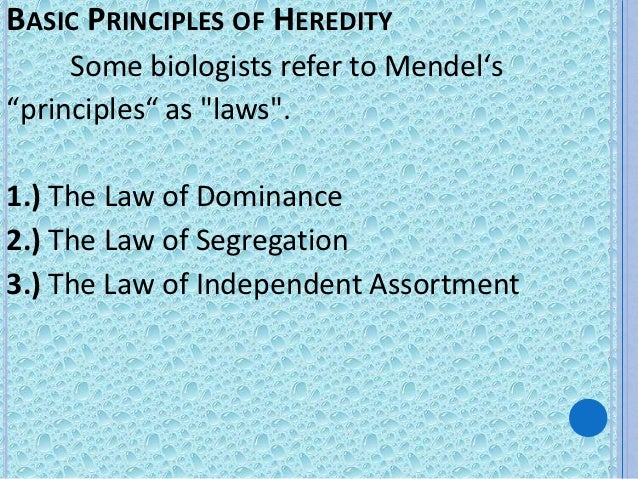
A specific place on a chromosome where all alleles for any par. - lots of offspring.
Chromosome Theory of Heredity.
Basic principles of heredity. Heredity refers to the transmission of traits from parents to offsprings. Heredity is responsible for the resemblance among individuals of the same species. Mendels Laws of Heredity.
Gregor Johann Mendel is known as the father of genetics. He was the first to show the inheritance pattern of traits from one generation to the next generation. Basic principles of Heredity.
The basic principle of heredity comes from the first theory that was proposed in 1866 by Gregor Mendel. Mendels research was based on the pea plant but the principles are applied to both plants and animals. It helps us to understand how we inherit different traits like eye and even the tongue rolling ability.
One reason Mendel discovered the basic principles of inheritance is that he a understood the behavior of chromosomes in mitosis and meiosis b studied a wide variety of experimental organisms c began by establishing true-breeding lines d studied various types of linkage e studied hybrids between parents that differed in many often not clearly defined ways. In cats blood-type A results from an allele IA I A that is dominant over an allele iB i B that produces blood-type B B. There is no O blood type.
The blood types of male and female cats that were mated and the blood types of their kittens follow. The three principles of heredity are dominance segregation and independent assortment. The law of dominance describes how different alleles interact.
See full answer below. Principle of heredity discovered by Mendel stating that when two different alleles are present in a genotype only one allele may be expressed in the phenotype. The dominant allele is the allele that is expressed and the recessive allele is the allele that is not expressed.
Chromosome Theory of Heredity. A specific place on a chromosome where all alleles for any par. - easy to grow.
- easy to cross. - can self. - lots of offspring.
Two alleles separate when gametes are formedone allele going. - easy to grow. - easy to cross.
- can self. - lots of offspring. 31 Gregor Mendel Discovered the Basic Principles of Heredity Gregor Mendel and his success in genetics Proper experimental model Used an experimental approach and analyzed results mathematically Studied easily differentiated characteristics.
Mendels use of the pea plant -. Rule of Dominance The trait that is observed in the offspring is the dominant trait uppercase The trait that disappears in the offspring is the recessive trait lowercase 120813 Pranabjyoti Das 10. One of these principles is now called Mendels law of segregation.
Mendels Law of Independent Assortment. This principle of heredity formulated by Gregor Mendel states that traits are transmitted to offspring independently of one another. Basic Principles of Heredity.
Offspring that are the result of mating between two genetically different kinds of parents–the opposite of purebred. Hybrid 2. The study of gene structure and action and the patterns of inheritance of traits from parent to offspring.
About Press Copyright Contact us Creators Advertise Developers Terms Privacy Policy Safety How YouTube works Test new features Press Copyright Contact us Creators. What was Mendels experiment to answer this question. - Removed the anthers from flowers to prevent self-fertilization.
- Dusted the stigma with pollen from a different plant. - The pollen fertilized the ova which developed into seeds and the seeds grew into plants. - Reproduced the experiment.
2Gregor Mendel developed some basic principles of heredity based on his 1 dissection of the flowers of both tall and short African violet plants 2 microscopic observation of the nuclei of fruit fly cells 3 biochemical analysis of DNA produced in theF 2generations of roan cattle. Two principles of heredity were formulated by Gregor Mendel in 1866 based on his observations of the characteristics of pea plants from one generation to the next. The principles were somewhat modified by subsequent genetic research.
The principle of independent assortment. According to the principle of segregation for any particular trait the pair of alleles of each parent separate and only one allele passes from each parent on to an offspring. Which allele in a parents pair of alleles is inherited is a matter of chance.
